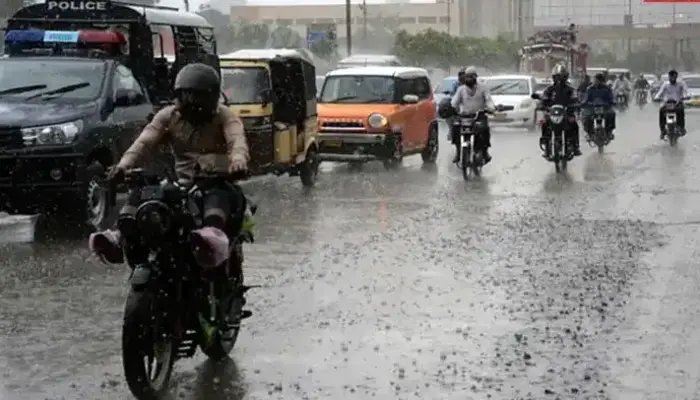
Pakistan is reeling under one of the deadliest monsoon seasons in recent memory, with relentless rains and surging floodwaters inundating vast parts of the country. At least 657 people have died and more than 920 have been injured since June 26, according to the National Disaster Management Authority (NDMA). The agency said cloudbursts, flash floods, house collapses and lightning strikes continue to batter communities.
Khyber Pakhtunkhwa (KP) remains the worst-hit province. Remote mountainous districts such as Buner have become the epicentre of tragedy. Rescue 1122 confirmed that its teams had recovered 373 bodies from flood-hit areas across KP, the majority from Buner.
“The Rescue 1122 has recovered 373 bodies from all the flood-hit districts of the province till Sunday while rescue and search operation is still underway,” spokesperson Bilal Ahmad Faizi told reporters.
Fresh rainfall on Monday worsened conditions. In Mardan, heavy showers drenched the city, while thunderous downpours struck Nowshera and nearby Swabi. Swat’s Mingora and Malakand also faced severe rainfall, paralyzing life in urban and rural areas alike.
In Buner, relief operations slowed as volunteers struggled to reach cut-off villages. Makeshift bridges risked collapse under strong currents, leaving many stranded. In Parachinar, flash floods swelled the Kurram River and washed away roads and embankments, disrupting access.
Urban Flooding Wreaks Havoc in Peshawar
In Peshawar, intermittent rain since Sunday night triggered urban flooding. Overflowing drains swamped major roads including Saddar Bazaar, University Road, Bara Road and Gulbahar. Streets turned into rivers, vehicles were submerged, and water entered houses and even the Western Police Station.
Tragedy struck in Nowshera’s Chakki Mamrez area when the roof of a room collapsed during heavy rain, killing a husband and wife.
Punjab and Balochistan Hit Hard
Punjab also witnessed persistent rainfall. Heavy downpours lashed Multan, Kabirwala, Jhang and Khushab, flooding low-lying areas. In Chakwal, rainfall ranged from 11mm to 67mm across different towns, while Bhakkar and Miani reported inundated neighborhoods.
Quetta and other areas of Balochistan remained cloudy and humid. The Pakistan Meteorological Department (PMD) forecast rain in Zhob, Musakhail, Mastung, Loralai, Kohlu and Kalat, with scattered showers likely in Dera Bugti, Khuzdar, Ormara, Pasni and Lasbela.
In Azad Kashmir, thunderstorms lashed Dhirkot and the wider Poonch division.
Read more: Punjab Flooding Worsens as Monsoon Rains Continue
Rivers and Dams Under Pressure
Rain-swollen rivers have placed dams and barrages under extreme pressure. Authorities issued flood warnings along the Indus. Medium flood levels were recorded at Kalabagh, Jinnah Barrage and Chashma Barrage in Mianwali. At Jinnah Barrage, water inflow stood at 439,586 cusecs, while Chashma reported 483,512 cusecs inflow.
In Kot Addu, inflows at Taunsa Barrage reached 454,356 cusecs. The Flood Forecasting Division said the Indus remains in medium flood at Tarbela, Kalabagh, Chashma and Taunsa, while Guddu Barrage is in low flood.
Reservoirs are filling fast. Tarbela Dam is now 97% full at 1,546.60 feet, while Mangla Dam stands at 71% capacity.
Death Toll Continues to Rise
The NDMA confirmed that among the 657 nationwide fatalities, 171 were children, 94 women and 392 men. KP alone accounted for 390 deaths. Punjab reported 164, Sindh 28, Balochistan 20, Gilgit-Baltistan 32, Azad Kashmir 15 and Islamabad Capital Territory eight.
Lieutenant General Inam Haider, chairman of NDMA, warned that this year’s monsoon intensity is “50 to 60 percent more than last year” and that at least two to three more spells are expected until September.
Climate Change Fuels Extreme Weather
Pakistan monsoon floods are not new, but the scale of destruction is intensifying. Chief meteorologist Zaheer Babar said climate change is driving frequent and powerful weather events. Heavy mountain downpours quickly transform into flash floods downstream, catching communities off guard.
He added that poor human practices—such as building along riverbanks and dumping garbage in waterways—worsen the devastation.
Pakistan ranks among the world’s most climate-vulnerable nations. In 2022, floods submerged one-third of the country and killed nearly 1,700 people. This year’s monsoon disaster once again highlights the urgent need for resilience and climate adaptation.
Monsoon System Strengthens in Sindh
The third day of the active monsoon system in Sindh brought record rainfall to Diplo with 116 millimeters. Eastern districts recorded between 40 and 60 millimeters. Karachi also witnessed light showers on Sunday evening.
Weather analysts warned that blazing sunshine and humid winds signal heavier downpours ahead for Karachi. Thunderstorms and rain are likely to form by this evening over the city and its surroundings.
Follow us on Instagram, YouTube, Facebook,, X and TikTok for latest updates




